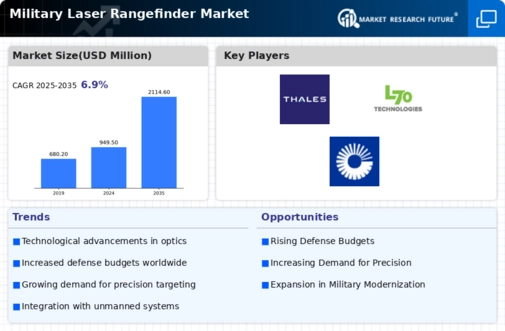Market Trends
Key Emerging Trends in the Military Laser Rangefinder Market
Advancements in Laser Technology: Simplified Explanation
The military strategies of many countries heavily depend on advanced laser weapon systems, which are changing the landscape of defense warfare. Even though these weapons are relatively new, they're bringing new ways to attack and defend against various targets. Unlike older weapons like nuclear high-altitude electromagnetic pulse (HEMP) weapons, laser weapons offer more tactical options, including better accuracy, limited damage, and the ability to attack multiple targets.
In recent years, there's been a lot of investment in guided laser weapons. Here are a few examples:
Raytheon created the Paveway IV air-to-ground laser-guided bombs, which are equipped with GPS/INS guidance systems. These bombs can be used in all weather conditions and are deployed on planes like the Tornado GR4, Typhoon, and the Joint Strike Fighter.
Raytheon developed the Pike semi-active laser-guided munition, a small missile that can be fired from a rifle-mounted grenade launcher. It's accurate and can be used on various platforms like unmanned aircraft systems, small boats, and ground vehicles.
Sudarshan, a laser-guided bomb kit, was developed for the Indian Air Force in 2014. It weighs about 990 lbs and has a range of around 6 miles.
Lockheed Martin created the Dual Mode Laser Guided Bomb (DMLGB), which is used by the US Navy. It has upgraded guidance systems for accurate targeting.
Although these laser weapons are advanced, they need to be very precise. If the laser rangefinder is turned on too early, they might miss their target. To avoid this, the weapons need a short designation time to hit exactly what they're supposed to without causing harm to nearby areas.
Ensuring Safety: Introduction of Eye-Safe Laser Rangefinders
Laser weapons can be dangerous to humans, especially if they're directed at the eyes. Even low-power lasers can harm eyesight, causing burns to the cornea and retina, leading to permanent blindness.
With the increased use of lasers in the military, there's a demand for laser systems that are safe for the eyes. This has led to the development of small, inexpensive, and user-friendly semiconductor diode lasers that operate at eye-safe wavelengths.
For instance, in 2016, the Defense Research and Development Organization (DRDO) introduced the Laser Cross Section Measurement & Imaging System (LACSMI). This laser rangefinder can measure laser signatures, generate 3D images, identify hotspots, and automatically track sea and airborne targets.
Similarly, the F-35 fighter aircraft was cleared to use a laser rangefinder in 2016 by the Defense Ranges Safety Committee, US. In 2010, Premier Electronics from the UK introduced a high-repetition, eye-safe laser rangefinder for military and aerospace applications, with a range of approximately 13 miles.

















Leave a Comment